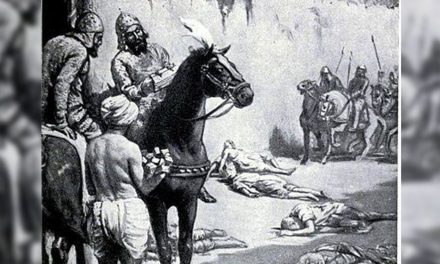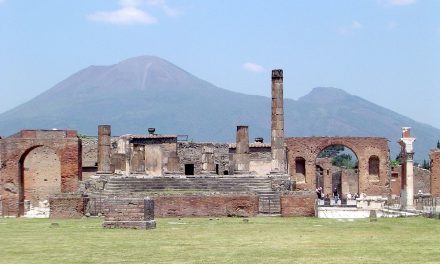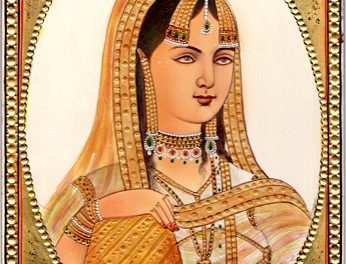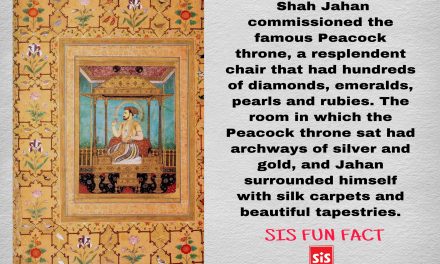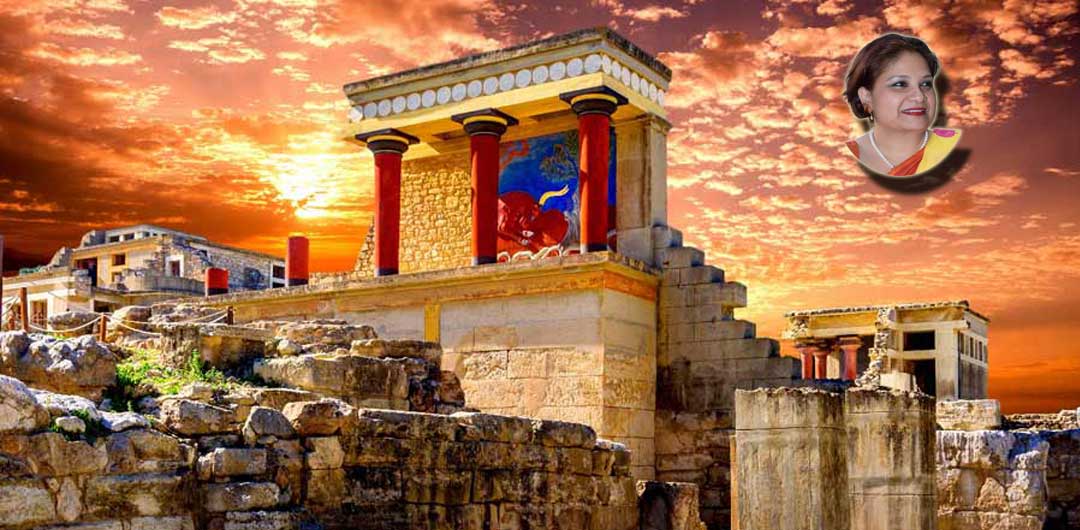
In 1450 BC, Knossos palace stood proudly in the Northern part of Crete. A grand ceremony of worship is going on in the palace premises. This arrangement is to satisfy the goddess for the good production of crops and protection from natural calamities. Yes, not gods, but only goddesses because they are worshipers of goddesses solely. The most interesting and important goddess of all is Sarpadevi. This very beautiful snake goddess has an ivory crown on her head, and snakes made of gold wrapped around her body.
The decoration of the palace is also worth admiring. Skilled painters have painted brightly coloured frescoes of dolphins, female figures, and foliage on the walls of the palace. Gamblers and dancers roam the streets, performing dances and feasting games. Fire is lit in clay pots to save them from the severe winter. The whole palace has been filled with the aura of incense.
On the other hand, bull worship is going on. According to the myth, the god Zeus swam to the island of Crete carrying Europa on his back in the form of a bull. For this reason, the Cretans worship the bull. Bulls also dominate their frescoes. Bull dance is also very popular among them.
The palace has three floors; sitting on the throne, the king keeps track of all the work through his ministers. Because in Crete the king is the highest priest of the state. He is the head of all military and civil affairs. But as a ruler, the king had no comparison. He loves his subjects very much. So, the people of the kingdom also respect him from the core of the heart. The king of Crete is peaceful and a stream of creativity.
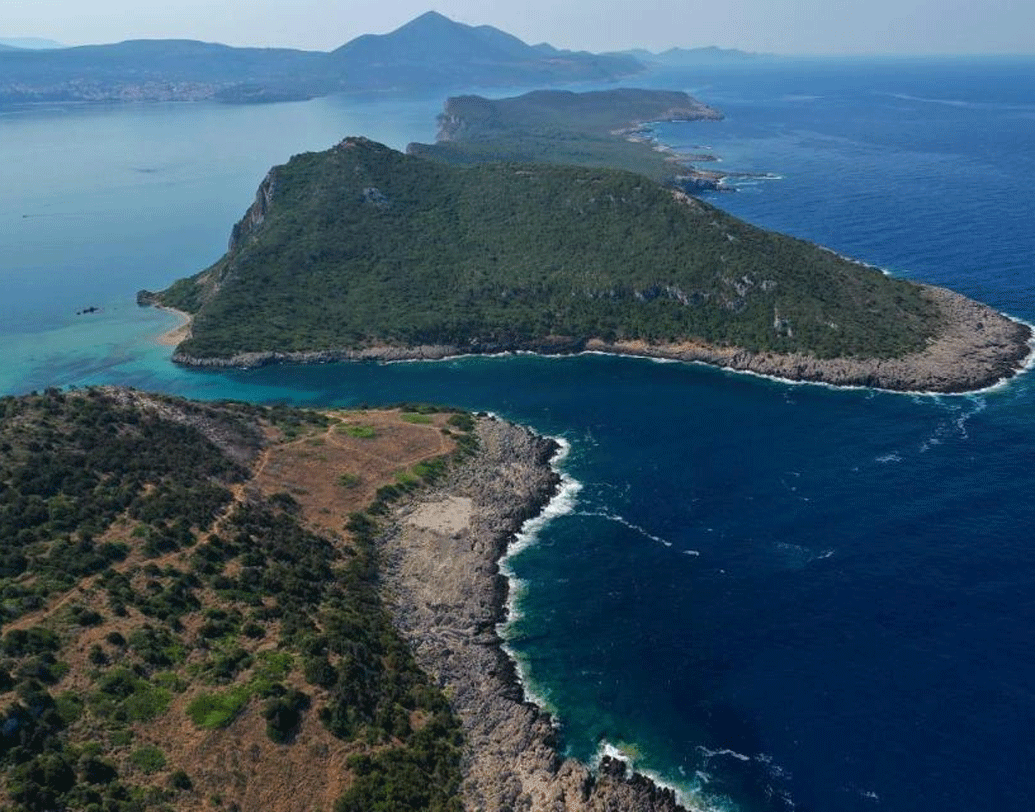
15 kilometers south of the Crete region of Greece is the Island of Chrysi. This Chrysei island was once the center of the Minoan civilization. © telegraphindia.com
Everything is trembling in the midst of so many arrangements of worship. They are quite used to the vibration of the sea, so no one took any consideration. But this time, the vibration is a little different, as the tremour is increasing. All of a sudden, the tsunami came seizing with darkness all around. Before anyone knew anything, the festive Knossos were destroyed. The unprecedented culture developed in Crete was destroyed, and an ancient progressive civilization, the Minoan Civilization, was lost under the expansion of the sea.
The Minoans’ civilization flourished from 2700 BC to 1470 BC. Then, after a natural disaster, this civilization slowly disappeared. It was completely destroyed in 1100 BC. Definitely the Minoans’ civilization was the first advanced civilization in Europe.
In 1894, the archaeologist Autther Evan lost his wife. His father was also a renowned archaeologist. Evan inherited his addiction to aimless wandering from his father. He did let the sorrow of his wife go in vain. Yes, he was the one who discovered the ruins of the city of Knossos on the island of Crete in 1894. In the beginning, he saw some seal-like amulets. It was undoubtedly the work of men! Being curious, Evans decided to go further and found the existence of this incredibly advanced civilization. When the world was introduced to this civilization, everyone was amazed. Many people also think that Crete is the island that Plato told about, the lost island of Atlantis, where the Minoans civilization developed. However there is not much evidence in this regard. The Minoan Civilization was destroyed by the tsunami caused by the eruption of Thera and lost under the sea.
The name Minoan was coined by Evans after the mythological king Minos. It is not known what they actually called themselves. For this reason, the civilization went unnoticed; Evans claimed that people did not know much about this because they were surrounded by sea. But this idea was wrong. In fact, many parts of the world had deep commercial ties with this nation that plowed the Mediterranean and the Aegean seas. The sea that separated them from the locality connected them with everyone as well, making them the most modern race. But the same sea that gave the Minoans such an amazing rise was responsible for their downfall.
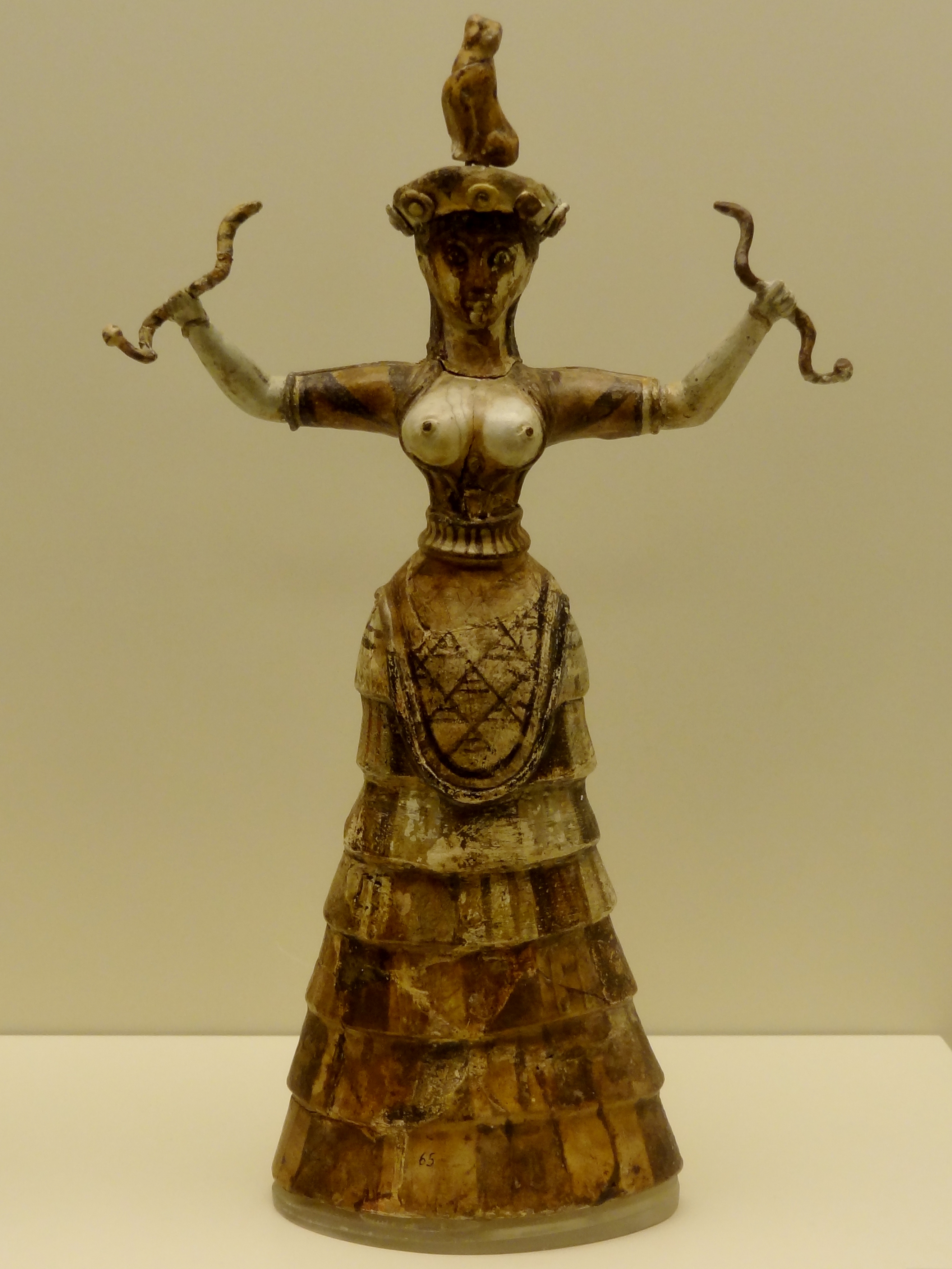
Snake Goddess © Wikimedia
So, who were the Minoins? How did they come to Crete surrounded by the sea? To learn about the Minoans and Crete, we have to look back to seven thousand years ago. The grains found by archaeologists in Crete from that period match those of ancient Anatolia. Therefore, it is believed that the original inhabitants of Crete migrated from Anatolia and came here. Even their DNA analysis proved that.
The development of the Minoans in Crete was not very time-consuming. The soil of Crete was fertile and they were skilled in agriculture. it was a Paradise on earth! Earlier, they used tools made of wood and bones for farming. They soon started the technique of producing multiple crops on the same land. Beekeeping and honey-making made them stronger. Gaining from the exporting of the surplus crops, they thought of making boats. Thus began the Minoan voyages of the sea. They emerged as unbeatable athletes on the sea route.

This Minoan civilization was completely destroyed in 1100 BC. The Minoan civilization is said to be the first progressive civilization in Europe. © telegraphindia.com
Although they had many achievements, they also had shortcomings. The most important material at that time was bronze, which required copper and tin to make. How could they let go of such a dominant element? In any case, this imperfection should also be compensated for. The name should be written in the book of excellence. A new effort had begun. The factory was built for the manufacturing of bronze ornaments. They also produced all other kinds of sought-after goods such as pottery, carved gold jewelry, olive oil, wine, special dyes for dyeing clothes – natural purple dye, ivory crafts, etc., and these products were traded to places like Cyprus, Egypt, and Mesopotamia. The Minoan Civilization of Crete became the hub of great trade.
The Minoans wrote many things on small clay tablets. The writing system is defined as ‘Linear A’. Maybe they had a history of their own. But the sad thing is even today it is not possible to decipher all those writings. As a result, the Minoans themselves remained elusive. However, hope was brought to relieve this despair by the murals of Cretan merchants painted on the pyramids of Egypt and another writing of a slightly different style, “Linear B,” with which some Indo-European languages are found to have similarities. The Egyptians called the Minoans “Keftyu”. The Minoans took many things, like cosmetics, leather, charms, pottery, etc., to trade with Egypt.
Minoan wall painting was found in the tomb of a close associate of Pharaoh Thutmose III at Tel-el-Daba in Egypt. Another fresco was found in the tomb of Rekh-meh -ri. Minoans frescoes are most commonly found to be depictions of bull-leaping. Bull leaping was one of the main rituals of the Minoans. Basically, it is a strange game of jumping over the bull’s back to stop the bull. This game is still played in some parts of France. Whereas in Spain, they have a game of bullfighting, which is their national event just as ours is Kabadi. In the Minoans’ times, such bull-leaping rituals were practiced to prove their strength, ability, and masculinity. There was an interesting ritual during the games. The Minoan women chose their husbands from the conquerors, which was something like the Swayamvar Sabha of Indian mythology.
The most valuable Minoan commodity for trade was a special purple dye for use in cloth, which has already been mentioned. It was made from the body of a snail. The colour is known as “Violet”. A lot of foreign income came from this very expensive paint. Its value was so high that later, Piny called this color more valuable than silver and the most preferred commodity of wealth.
Boats were the means of sea trade, and wood was also within reach of the Minoans. Therefore, from the thought of trade by sea, they focused on making better and better boats. Due to the geographical location of the island of Crete, it was easy for them to trade with different countries by sea. Egypt could be reached within 28 days by boat. Moreover, with mountains on one side and the sea on the other, there was less fear of attack by the outside forces. Though they were brave, they did not hide themselves for fear of enemies. Rather, they opened all the ports to encourage people from other countries to come and do business in their own territory for the purpose of economic development. This is how the agriculture Minoans gradually became traders.

Merchants of Crete in Egyptian wall paintings
Knossos must be mentioned. Many prosperous cities developed in Crete, but Knossos was the most important city on the Mediterranean side. The city was embedded with huge palaces surrounded by hills. The palace was actually a collection of several buildings. There were endless rooms in the palace. There were living rooms, dining rooms, meeting rooms. There were also special rooms for queens, which had modern bathroom facilities. The two tire walls of the palace kept noise away. In the middle was a courtyard. From the window of the King’s room, the magnificent blue beauty of the Mediterranean could be seen directly. Some parts of the palace were multi-storeyed, with wide stairs. The solid pillars were made of wood and brick.
The inner walls of the palace were gray in colour with frescoes painted on them. All the pictures of daily life and society were painted. The marine life, sea animals, hunting scenes, and foliage ornaments were attractive. Although the method of painting colorful pictures is somewhat old-fashioned, the artists created those beautiful scenes by mixing the sweetness of the mind with the use of different colors. They also acquired the technique of making new colours by mixing pigments. The number of sculptures was not very high, but the very few there had much delicacy in making. The animal figures look very alive. An image of a bull catches everyone’s attention. The head slightly tilted, gazing with shining eyes. Its eyes seem to penetrate the viewer’s heart. Potters used bright colours to create vivid images and designs on smooth vessels. The beauty of the vessels was not less than porcelain. Beautiful gold bowls were also found, undoubtedly symbols of Minoan nobility.

Archaeologists have only recently discovered the vast wealth of this Minoan civilization. They dug the soil of Chrysi and recovered gold jewelry and many valuable resources. © telegraphindia.com
I mentioned in the beginning that the goddess is their main idol. Though they believed themselves to be the children of the Greek god Zeus, the worship of the goddess was central to them. In the matriarchal Minoan society, different goddesses were worshiped for each task. Special goddesses were also worshiped to save them from calamities. They believed that all power was in the hands of the goddess. Behind all good and bad deeds of the world is the will of the goddess. As assistants to the main goddess, they believed in the presence of the serpent goddess in charge of the underworld, the goddess of wild animals in charge of the earth, and the dove, the goddess of heaven. They did not build temples for worship. Instead, they used to pray to the goddess for the desired goal by sitting in the open sky, under the mountain caves, under a tree, or on the top of a mountain.
The earliest Minoan Civilization in Crete underwent an unimaginable advance. Even being in the middle of the ocean, they were not behind by any means at that time; rather were several hundred years ahead. They thoroughly utilized their talent and labour and left for us the seeds of learning. Crete has given birth to many firsts- the first dual carriageway, and the first use of a flush toilet, each were awe-inspiring. Even in such ancient times, women were valued the most; there was no question of rights and abuse among them. Not only was a population lost in the terrifying tsunami, but also the vestiges of an incredibly potential civilization were lost.
Related post: Ditropan
You’ll be interested: Elavil

